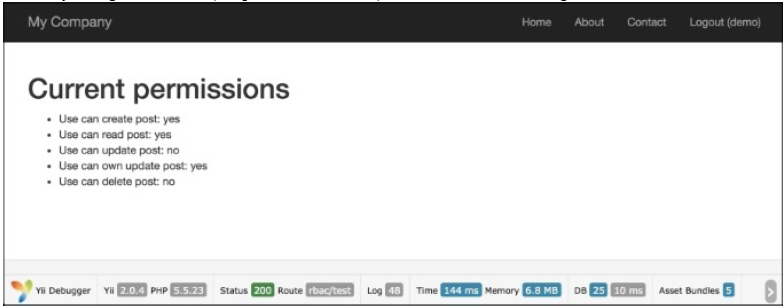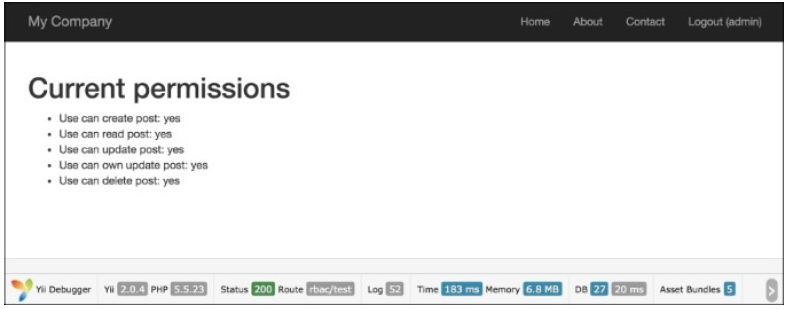使用RBAC
基于角色的访问控制(RBAC)提供了简单但是非常强大的中心化访问控制。它是Yii中最强大的访问控制方法。在指导中有关于它的描述,但因为比较复杂和强大,如果不了解一些底层原理的话,比较难以理解。
在本小节中,我们将会take the roles hierarchy from the definitive guide, import it, and explain what is happening internally.
准备
- 按照官方指南http://www.yiiframework.com/doc-2.0/guide-start-installation.html的描述,使用Composer包管理器创建一个新的应用。
- 创建一个MySQL数据库并配置。
- 在
config/main.php和config/console.php中配置authManager组件:
return [
// ...
'components' => [
'authManager' => [
'class' => 'yii\rbac\DbManager',
],
// ...
],
];
- 运行migration:
yii migrate --migrationPath=@yii/rbac/migrations
如何做…
执行如下步骤:
- 创建访问规则
rbac/AuthorRule.php:
<?php
namespace app\rbac;
use yii\rbac\Rule;
/**
* Class AuthorRule.
* @package app\rbac
*/
class AuthorRule extends Rule
{
public $name = 'isAuthor';
/**
* @param int|string $user
* @param \yii\rbac\Item $item
* @param array $params
*
* @return bool
*/
public function execute($user, $item, $params)
{
return isset($params['post']) ?
$params['post']->createdBy == $user : false;
}
}
- 创建一个控制台命令
command/RbacController.php,initRBAC规则命令:
<?php
namespace app\commands;
use app\models\User;
use Yii;
use yii\console\Controller;
/**
* Class RbacController.
* @package app\commands
*/
class RbacController extends Controller
{
public function actionInit()
{
$auth = Yii::$app->authManager;
$createPost = $auth->createPermission('createPost');
$createPost->description = 'Create a post';
$updatePost = $auth->createPermission('updatePost');
$updatePost->description = 'Update a post';
$updatePost = $auth->createPermission('updatePost');
$updatePost->description = 'Update a post';
$deletePost = $auth->createPermission('deletePost');
$deletePost->description = 'Delete a post';
$readPost = $auth->createPermission('readPost');
$readPost->description = 'Read a post';
$authorRule = new \app\rbac\AuthorRule();
// add permissions
$auth->add($createPost);
$auth->add($updatePost);
$auth->add($deletePost);
$auth->add($readPost);
$auth->add($authorRule);
// add the "updateOwnPost" permission and associate the rule with it.
$updateOwnPost = $auth->createPermission('updateOwnPost');
$updateOwnPost->description = 'Update own post';
$updateOwnPost->ruleName = $authorRule->name;
$auth->add($updateOwnPost);
$auth->addChild($updateOwnPost, $updatePost);
// create Author role
$author = $auth->createRole('author');
$auth->add($author);
$auth->addChild($author, $createPost);
$auth->addChild($author, $updateOwnPost);
$auth->addChild($author, $readPost);
// create Admin role
$admin = $auth->createRole('admin');
$auth->add($admin);
$auth->addChild($admin, $updatePost);
$auth->addChild($admin, $deletePost);
$auth->addChild($admin, $author);
// assign roles
$auth->assign($admin, User::findByUsername('admin')->id);
$auth->assign($author, User::findByUsername('demo')->id);
echo "Done!\n";
}
}
- 在控制台中运行:
yii rbac/init
- 创建
controllers/RbacController.php:
<?php
namespace app\controllers;
use app\models\User;
use stdClass;
use Yii;
use yii\filters\AccessControl;
use yii\helpers\Html;
use yii\web\Controller;
/**
* Class RbacController.
*/
class RbacController extends Controller
{
public function behaviors()
{
return [
'access' => [
'class' => AccessControl::className(),
'rules' => [
[
'allow' => true,
'actions' => ['delete'],
'roles' => ['deletePost'],
],
[
'allow' => true,
'actions' => ['test'],
],
],
],
];
}
public function actionDelete()
{
return $this->renderContent(
Html::tag('h1', 'Post deleted.')
);
}
/**
* @param $description
* @param $rule
* @param array $params
*
* @return string
*/
protected function renderAccess($description, $rule, $params = [])
{
$access = Yii::$app->user->can($rule, $params);
return $description.': '.($access ? 'yes' : 'no');
}
public function actionTest()
{
$post = new stdClass();
$post->createdBy = User::findByUsername('demo')->id;
return $this->renderContent(
Html::tag('h1', 'Current permissions').
Html::ul([
$this->renderAccess('Use can create post',
'createPost'),
$this->renderAccess('Use can read post',
'readPost'),
$this->renderAccess('Use can update post',
'updatePost'),
$this->renderAccess('Use can own update post',
'updateOwnPost', [
'post' => $post,
]),
$this->renderAccess('Use can delete post',
'deletePost'),
])
);
}
}
- 运行一次
rbac/test检查access to all the created permissions of the RBAC hierachy:

- 然后尝试使用
demo登录(密码是demo),再次运行rbac/test:

- 然后尝试使用
admin登录(密码是admin),再次运行rbac/test:

- 用
demo用户登录,运行rbac/delete:

- 用
admin用户登录,运行rbac/delete:

工作原理…
Yii模仿NIST RBAC模型实现了一个一般的层次化的RBAC。它通过应用组件authManager提供了RBAC功能。
RBAC层级是一个有向无环图,也就是说,它由结点和有向连接边组成。有三种类型的结点:角色、权限和规则。
角色是权限(例如创建帖子和更新帖子)的集合。一个角色可以分配给一个或多个用户。为了检查用户是否有某个指定的权限,我们可以检查这个用户是否被赋予了拥有该权限的角色。
角色和权限都可以以等级化的方式组织。特别地,一个角色可以包含其它角色和权限,并且权限可以包含其它权限。Yii实现了一个偏序层级,它包含了特定的tree等级。当一个角色包含一个权限时,反过来说是不正确的。
为了测试权限,我们创建了两个动作。第一个动作是test,包含了创建权限和角色的检查器。第二个动作是delete,它被访问过滤器限制了访问。访问过滤的规则如下所示:
[
'allow' => true,
'actions' => ['delete'],
'roles' => ['deletePost'],
],
这意味着,我们允许所有拥有deletePost权限的用户运行deletePost动作。Yii以检查deletePost权限开始。注意到访问规则元素被命名为roles,你可以指定一个RBAC等级节点,无论是角色、规则还是权限。检查updatePost是复杂的:
Yii::$app->user->can('updatePost', ['post' => $post]);
我们使用第二个参数来传递一个帖子(在我们的例子中,我们使用stdClass来模拟它)。如果用户以demo登录,然后获得了updatePost的权限。如果你很幸运,你只需要go through updatePost,updateOwnPost和作者。
因为updateOwnPost有一个定义好的规则,它会在传参给checkAccess时运行。如果结果为真,访问将会得到授权。因为Yii不知道最短的方法是什么,它会尝试检查所有可能性直至成功,或者没有剩余的备选项。
更多…
下面是一些有用的技巧,能让你更方便的使用RBAC。
保持层级简单和高效
遵守如下建议来提升性能,并降低层级复杂性:
- 避免给一个用户关联多个角色
- 不要连接相同类型的结点:例如,避免连接两个task
命名RBAC结点
一个复杂的层级如果不使用一些命名习惯的话会很难理解。能帮助我们降低复杂性的惯例是:
[group_][own_]entity_action
只有当当前用户是元素的拥有者时,才能修改这个元素的能力。这是,会使用own这个关键词。group只是一个命名空间。entity是我们工作的实体名称,action是我们执行的动作。
例如,如果我们需要创建一个规则,它决定了用户是否可以删除一个博客文章,我们把它命名为blog_post_delete。如果这个规则决定了用户是否可以编辑他自己的评论,我们将会把它命名为blog_own_comment_edit。
参考
为了了解更多关于SQL注入和使用Yii处理数据库,参考如下链接: